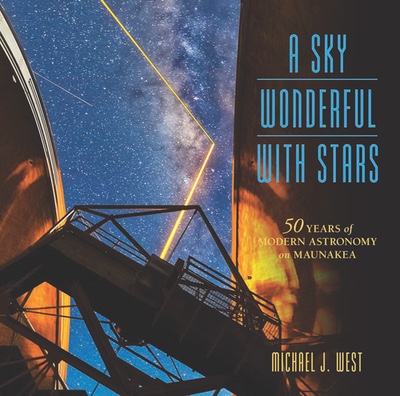Review: A Sky Wonderful with Starsby Jeff Foust
|
| The book is a celebration of the modern era of astronomy atop the mountain, which started with a couple small telescopes and now includes some of the world’s largest and most productive. |
Little has changed in the intervening months, including a blocked effort to restart construction in June. In recent weeks, protestors who had camped out overnight on the mountain—in violation of rules put into effect after the protests started—agreed to leave, assured by state officials that construction crews would not attempt to head to the TMT site during the night. The Hawaii Supreme Court is reviewing a challenge to a permit issued by the state’s Department of Land and Natural Resources allowing construction of the telescope, and University of Hawaii officials said recently they’re dealing with legal bills now in excess of $2 million.
That debate—about not just the future of the TMT but astronomy in general atop Maunakea—is avoided in A Sky Wonderful With Stars, a book by astronomer Michael West, the deputy director of the Lowell Observatory in Arizona and a former professor at the University of Hawaii. Instead, the book is a celebration of the modern era of astronomy atop the mountain, which started with a couple small telescopes and now includes some of the world’s largest and most productive.
A Sky Wonderful With Stars covers that history of astronomy on Maunakea in three parts. After a brief introduction to the mountain itself, the book goes through the development of astronomy there. That modern era of astronomy began in 1964 when astronomer Gerard Kuiper visited the summit as part of a search for the best observation site in the world. The clear, stable skies there won him over, although he personally did not reap the rewards of his search: NASA funded a competing proposal to build what became the 2.2-meter (88-inch) University of Hawaii telescope there. That telescope, completed in 1970, is the oldest active one on Maunakea today (two small telescopes, placed there in the 1960s, have since been retired.)
Other observatories would follow, drawn by the skies that wowed Kuiper and generations of astronomers who would follow him. Those telescopes now include the twin 10-meter telescopes of the Keck Observatory, the 8.2-meter Subaru Telescope, and the 8-meter Gemini North Telescope, among others. While best known for its optical and infrared observatories, Maunakea is also home to telescopes that operate at longer submillimeter wavelengths and a radio dish that is part of the Very Long Baseline Array.
The history of Maunakea astronomy is told in both words and large color images, as is the book’s final section, a review of the astronomy performed by those observatories. Images of objects ranging from planets in our own solar system to distant galaxies, all produced by observatories on the mountain, fill this section, with brief descriptions of both their science and how they were created.
| Maunakea’s skies may be wonderful with stars, but its future in astronomy may not be nearly as wonderful, a topic worth exploring as much as the science done there. |
If your sole knowledge of astronomy on Maunakea came from A Sky Wonderful With Stars, you’d finish the book thinking how, well, wonderful astronomy is atop the mountain. (The unusual title comes from the account of a Victorian-era travel writer who visited the summit in 1873.) The TMT is included in the book as a planned future observatory, but there’s no mention of the controversy surrounding its construction, or concerns by some native Hawaiians about astronomy on Maunakea in general.
That omission aside, A Sky Wonderful With Stars is a beautiful book that illustrates, in words and photos, the facilities atop Maunakea that have opened the universe to scientists and the broader public. But even if the TMT is eventually built—and astronomers remain optimistic it will—the future of astronomy will likely look different on Maunakea. Hawaii Gov. David Ige has suggested that as many as a quarter of the existing observatories may need to close before TMT is completed in the 2020s. One, the Caltech Submillimeter Observatory, shut down earlier this month; it will be dismantled and its site returned to its original condition. Maunakea’s skies may be wonderful with stars, but its future in astronomy may not be nearly as wonderful, a topic worth exploring as much as the science done there.
